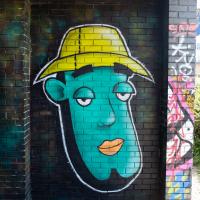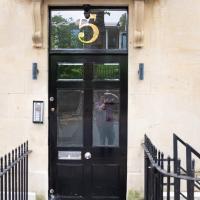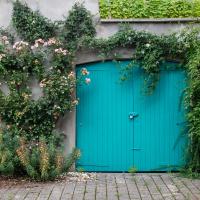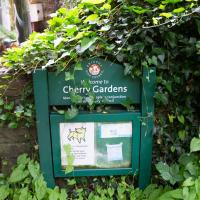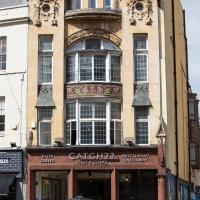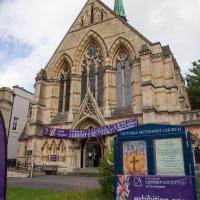Tagged: door
Bank Holiday Street Art
31 May 2021
A nice warm Bank Holiday Monday saw me walk back over to Bedminster to do justice to something we glimpsed on my last wander. Along the way I spotted a couple of new pieces of street art tucked away on the south side of the Cumberland Basin Flyover system, so this turned into a micro-graffiti walk.
Set back behind the shops on the main road is this little pair of houses. All well-kept and tidy, and not quite as odd a place to be as the one that's isolated in the car park behind them, but still quite a strange location.
A Longer-than-it-looks Walk With Lisa
06 Jun 2021
The track on the map doesn't tell the whole story of this walk with Lisa around and about Clifton, Berkeley Square, Brandon Hill and the harbourside, because the batteries on my GPS ran out while we were on the roof of Trenchard Street car park, it seems. Oh well. I think I did most of the area I was interested in finishing off around the University; there were only a few new bits around Brandon Hill that won't be on the track, and I can easily do them again.
Still, technology woes aside it was a nice walk, albeit a bit warm for climbing all those hills, and sat on the harbourside watching the world go by for a while, too. It was good to see the Bristol Ferry Boats carrying people around again, especially.
A snap in the entrance of the Transylvanian restaurant on Park Street, leaning into their image as hard as possible.
Leigh Woods Solo
19 Jun 2021
I hadn't really planned to go out for a wander yesterday; I just got the urge and thought "why not?" (Well, the weather forecast was one possible reason, but I managed to avoid the rain, luckily.)
I wanted to finish off the A369—as it turns out I may still have a small section to go, but I've now walked the bulk of it out to my one-mile radius—and also a few random tracks in Leigh Woods. I'm still not really sure that I'm going to walk them all, especially after discovering today that "the map is not the territory" applies even more in the woods, where one of the marked tracks on the map wasn't really that recognisable as a track in real life... I'm glad I'd programmed the route into the GPS in advance!
Anyway. A pleasant enough walk, oddly bookended, photographically at least, by unusual vehicles. Leigh Woods was fairly busy, especially the section I'd chosen, which was positively dripping with teenage schoolkids with rah accents muttering opprobrium about the Duke of Edinburgh. I'm presuming the harsh remarks were more about taking part in his award scheme than the late Consort himself, but I didn't eavesdrop enough to be certain...
Library, Bookshop, Coffee
03 Jul 2021
I was headed into town to return RA Gilbert's biography of AE Waite to the library and along the way I noticed that Dreadnought had finished their refurbishment, but wouldn't be open until midday. That left me some time to kill, so I bimbled around the old St Augustine's/Gaunt's area for a while, then headed up Park Street for a coffee and a snack to eat on Brandon Hill before heading home the way I'd came so I could pop in and buy a pamphlet on the Hot Well I'd been interested in for a while.
I was desperately looking for anything vaguely like a niche and ended up taking some improbable photos of very dull things. You'll be glad to know I binned the rest.
Interesting logo. Apparenlty milk and honey feature prominently in their menu. Not one for the vegans, I'm guessing.
I had no idea that both branches of London Camera Exchange (I always favoured the tiny shop at the end of Baldwin Street, but they also had one on the Horsefair) had been consolidated into a single shop on Park Street. It looks nice and shiny and modern, but I shall miss the quirk of the Baldwin Street shop.
This used to be the Park Street Convenience Store (formerly a Spar), which I don't think I ever set foot in, so it certainly has a lot more appeal to me now.
Call me thick, but I think this may be the first time I've realised what Coffee Under Pressure's acronym is. D'oh. (You could also call me think just looking at the outline of me reflected in the window. I do need to lose some more weight...
A Cliftonwood Revisit with Lisa
10 Jul 2021
Lisa had a couple of hours to spare before going up in a hot air balloon (exciting!) so we went for a quick local walk, revisiting a bit of Cliftonwood we've seen before, exploring the secret garden I'd visited before that I thought she'd enjoy (I didn't take any new photos there) and then pushing on to another garden, Cherry Garden. Last time we passed this way, I'd noticed the gate, but we hadn't gone in as I'd assumed it was private. I'd since found it on CHIS's list of communal gardens in Clifton, so I wanted to have a look inside this time, and try to figure out whether it was private-communal or public, and possibly Council-owned, like several of the other gardens in Clifton.
I'm assuming it doesn't get opened much, or there'd be a little more pruning going on. Still, very pretty for a garage...
"Managed by local people in conjunction with Bristol City Council", confirming its status as a public space, so I'm definitely not trespassing. Good.
Seemed to be open and busy, which is good. It's always been a good, friendly pub, but I understand it's been on the verge of closure a couple of times recently.
...with the end of "Jacobethan" Transit Shed "E". The end facing and baroque tower were apparently created to make looking this way from the centre a bit more pleasant; it's fairly plain further down. This is a smidge outside my one mile, but I was interested in the gates, having spotted them in a historic photo in one of my research books—see next pic.
There are some other pics from earlier times on the Watershed's web site, including one from 1981, not long before the E and W sheds were transformed into the complex that houses the excellent Watershed Cinema, their Cafe Bar, the Pervasive Media Studio and other modern features.
Pastures New!
17 Jul 2021
Okay, not much in the way of actual pasture to be had in Bedminster these days, like most of Bristol, but I did take advantage of the current rather toasty weather in Bristol to go and sit under a tree in Greville Smyth Park to read a book for a while before firing up the GPS and taking a little detour around some back streets of Ashton and Bedminster rather than going straight to Coffee #1 for an espresso frappé. This is the first walk in a while where I've actually crossed off an entire new street (the frankly unexciting Carrington Road) as well as exploring a couple of back alleys, just because they were there, really. Along the way I spotted a few examples of graffiti of various qualities, including a live work-in-progress by SNUB23 on Ashton Road and the finished Six Sisters project on North Street.
By all accounts a fine cafe in the greasy spoon archetype. Top right you can see a little tribute to Ashton Gate football stadium, a stone's throw away. Currently the stadium is being used as a Covid-19 vaccination centre.
This Scandinavian design shop has replaced the Hobbs House Bakery Cafe. While I enjoy Scandinavian design, anyone who's looked at my interior design and then looked at my actual exterior can fairly swiftly work out that I enjoy bread rather more. Still, I can get my hands on a Sherston Overnight White (best loaf in the world for toasting, according to both Hobbs House and to me) elsewhere, and clearly Mon Pote needed the extra space—this location is four times the size of their previous one, which was also much further up the road.
This is the end-stop for the Brunel swing bridge. Looks like someone's been doing a bit of restoration. I didn't actually check to see if it still had "HERE LYETH I K BRUNEL" carved on the back by some wag; I did at some point in the past...
A Journey to the Far East
25 Jul 2021
The far east of the intersection of my one-mile radius and Bedminster, anyway. I was feeling a bit tired this morning, so I motivated myself to get out of the door by imagining one of Mokoko's almond croissants. That got me on my way, and I wandered across to Bedminster, through Greville Smyth Park, along most of the length of North Street (looking out for new Upfest 75-pieces-in-75-days artwork as I went) and then onto some new roads at the far end.
I only wanted to knock a few streets off my "to do" list, but by the time I'd diverted here and there to check out various bits of graffiti and other attractions and come back via the aforementioned purveyors of Bristol's finest croissants, I'd walked 7.4km. Not bad for someone who woke up tired, and at least I've done something with my day. I'm very glad the weather broke (we had tremendous thunderstorms yesterday), even if some of the pictures might've looked better with a blue sky. I was getting fed up with walking around in 29°C heat...
A Film Is Not Dead production, apparently. If I'd known I'd have brought one of my film cameras. This would probably look pretty good on the extremes of either Ektar or Lomo Metropolis.
One of those streets with Bedminster's tradition of named houses in evidence. I do enjoy them.
The word "woodbine" always reminds me of The Secret Diary of Adrian Mole, where Bert Baxter smoked Woodbine cigarettes. I see that they were invented by Wills Tobacco, presumably in Bristol, and I'd guess not that far away—Wills was founded in Bristol, and the Tobacco Factory bar on North Street was actually a Wills factory. They had offices nearby, too.
I imagine this house was named for the honeysuckle, though...
Green Squares and Secret Gardens
31 Jul 2021
At the end of July I went to have a look around some of the private gardens opened up by the annual Green Squares and Secret Gardens event. Sadly it was compressed into a single day this year, for various Covid-related reasons, it seems, so I didn't get to poke around too many places. I went to:
- A talk by the oldest resident of Victoria Square
- The St Vincent's Rocks Hotel garden
- The Paragon garden
- Cornwallis Crescent gardens, both east and west
- The Polygon garden
And snapped a few things in between, too. It was a lovely day—a bit too hot, if anything—and it was interesting to get into a few places I'd only ever seen from the outside, especially The Paragon and Cornwallis gardens, which are the least visible to passing strangers of all of them.
I've been wanting to go through these gates for a while; you can only get tantalising glimpses of the listed extension from the bit of grass adjacent.
A Long Wander Of Miscellany and Magick
08 Aug 2021
This was a wide-ranging wander. I started off crossing the river to Bedminster, to walk a single little cul-de-sac, Hardy Avenue, that I'd managed to miss on at least one previous walk. Then, pausing only to explore a few back alleyways, I headed for a few destinations related mostly by the Hughes family, who I've been researching a little as part of background for a possible novel, as several of them were involved in the Stella Matutina.
However, mostly it's the artistic side of the family I wanted to explore today, as that's where most of their public history lies (as you might expect, there's often not much in the public record about the workings of an occult organisation.) First I visited College Green, where the façade of the Catch 22 Fish & Chip shop still bears the work of Catherine Edith Hughes. Then I wandered up to the top of Park Street to pop into the Clifton Arts Club's annual exhibition, as Catherine, her half-brother Donald, his wife Hope and at least two other Hugheses were members. Donald was chairman for 40 solid years; Hope was Secretary for eight, and Ellard and Margaret Hughes, two more Hughes siblings, were members along with Catherine.
Finally I walked home with a small diversion to Berkeley Square, to confirm the location of Donald Hughes's house by checking for a particular plaque by the front door.
I must admit I'm not entirely sure where all this research is really leading me, but I'm finding it quite interesting to bump across the faint lines of history that link the Hermetic Order of the Golden Dawn, founded in 1888, to modern, quotidian Bristol.
My guess is that these rental parking spaces are very popular when there's a match on at Ashton Gate. I could hear the cheering coming from the stadium from my front room in Hotwells over this weekend (I'm writing this on October 3, 2021, as I've got a bit of a photo-processing backlog!) so it seems that biggish matches—either football or Rugby or both—are back on.
The RWA is having extensive work done, including fitting a new lift on the outside (on the far side from here) so people who have trouble with stairs don't have to use the frankly terrifying freight lift.
Mostly the Metal Animals of a Clifton Garden
30 Aug 2021
Lisa and I went for a longish walk, but I didn't take many photos. Mostly we just wandered and nattered. Unusually, my target was outside my 1-mile radius on Burlington Road in Redland, where I snapped quite a few photos of the collection of artistic animals by Julian Warren. This was mostly to provide a fairly arbitrary destination for a roundabout walk in Clifton...
More dual numbering. I was curious, as I think the first couple of houses of the Colonnade were demolished at some point, so I wanted to see whether (a) the old numbers were there at all, rather than just the new Hotwell Road numbers, and (b) if they maybe started at number 3...
We popped in. I bought one of Ngaio Marsh's books of Inspector Alleyn stories. The community bookshop is run to benefit Studio Upstairs, an arts and health charity. The Bristol branch is down on the Albion Dockside estate behind Bristol Marina.
Since I found out that Angela Carter used to live around here, I've read The Bloody Chamber, and it was bloody brilliant.
